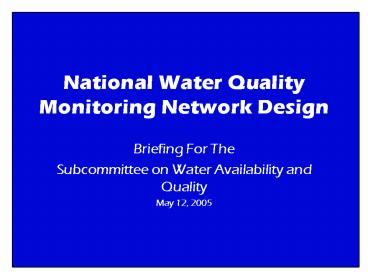National Water Quality Monitoring Network Design - PowerPoint PPT Presentation
1 / 24
Title:
National Water Quality Monitoring Network Design
Description:
Subcommittee on Water Availability and Quality. May 12, 2005 ... US Geological Survey. 2 Schumann Road. Westerly, RI 02819. gmallard_at_usgs.gov. 401-322-0902 ... – PowerPoint PPT presentation
Number of Views:106
Avg rating:3.0/5.0
Title: National Water Quality Monitoring Network Design
1
National Water Quality Monitoring Network Design
- Briefing For The
- Subcommittee on Water Availability and Quality
- May 12, 2005
2
Origins of the Proposal
- An Ocean Blueprint for the 21st Century
- Final Report of the U.S. Commission on Ocean
Policy
The US Ocean Action Plan The Administrations
Response
Both called for the creation of a National Water
Quality Monitoring Network
3
Monitoring Problems Cited
- Combined (existing) efforts do not constitute a
comprehensive, coordinated water quality
monitoring network - coastal waters are under monitored
- Data
- Exchange is complex and unwieldy
- Hoarded by agencies researchers
- Few of the 200 sites in the National Atmospheric
Deposition Program are in coastal areas
4
National Water Quality Monitoring Network
- Three Recommendations
- Develop network that coordinates and expands
- existing efforts
- The network should include coverage in both the
coastal and upland areas that affect them, and be
linked to the Integrated Ocean Observing System - Network must have clear goals, specify core
variables, and an appropriate sampling framework,
and be periodically reviewed and updated.
5
- Council is a 35-member committee under the
Advisory Committee on Water Information (ACWI) - ACWI is Chartered under the Federal Advisory
Committee Act - ACWI members accepted task from CEQ and NSTC for
Council to Design a National Water Quality
Monitoring Network (NMN) - Council has already developed many products to
address these problems (see Council brochure)
6
National Water Quality Monitoring Network
Councils Organization of the Effort
7
2
7
40
28
23
8
Approach to the Design
- Design the network using criteria derived from
- Specified goals and objectives
- Management questions
- Compare design with existing monitoring efforts
- Then
- Retain
- Add or Extend
- Enhance
- Define as external to the Network
9
Goals of the National Water Quality Monitoring
Network
- Integrate, coordinate, and as necessary enhance
water quality monitoring efforts needed to make
informed management decisions for sustainable use
of aquatic resources. - Communicate the availability of quality assured
data, and disseminate information products
relevant to national, regional and local needs.
10
Objectives of the National Water Quality
Monitoring Network
- 1. Define status and trends of key water quality
parameters and conditions on a nationwide basis. - 2. Provide data relevant to determining whether
goals, standards, and resource management
objectives are being met, thus contributing to
sustainable and beneficial use of coastal and
inland water resources. - 3. Provide data to identify and rank existing and
emerging problems to help target more intensive
monitoring, preventive actions, or remediation. - 4. Provide data to support and define coastal
oceanographic and hydrologic research, including
influences of freshwater inflows. - 5. Provide quality-assured data for use in the
preparation of interpretive reports and
educational materials.
11
Management Questions
- What is the condition of the Nations surface,
ground, estuarine, and coastal waters? - Where, how, and why are water-quality conditions
changing over time? - Where are the problems related to water quality?
- What is causing the problems?
- Are programs to prevent or remediate problems
working effectively? - Are water-quality goals and standards being met?
- What research activities are needed to support
these important resources?
12
The Six Environments
- Major river systems and major tributaries of
those primary drainages - Estuaries,
- Outlets of major estuaries and bays
- Near-shore coastal zone
- Regional aquifers
- Great Lakes
13
Stressors Affecting Resources
- Oxygen depletion
- Nutrient enrichment
- Toxic contamination
- Sedimentation
- Harmful algal blooms
- Habitat degradation
- Invasions by exotic species
- Pathogens (indicator bacteria)
14
Regional IOOS Associations
15
National Water Quality Monitoring Network
- Challenge
- Common information goals
- Compatible design approaches
- Sampling timing
- Metadata standards
- Parameter specifications
- Field data collection handling
- Analytic procedures
- Data storage, and data access practices
16
Major Rivers of the Conterminous U.S.
17
Cumulative Drainage and Streamflow in Major
Conterminous U.S. Rivers
18
Dissolved Oxygen in the Chesapeake Bay
- Illustrates the gap between what monitoring
exists and what monitoring is useful to
management
19
Initial Network Design for Nontidal Monitoring
703 Stream Gages
gt1700 Water Quality
- 313 Active Stream Gages 389 Active Water-Quality
176 WQ Associated with Stream Gages
118 Sites Meet Frequency and/or Parameter
Criteria for trends
20
Progress To Date
- Focusing on the issue of oxygen depletion
- Assembling parameter lists for marine estuarine
waters - Contacting other case study areas
21
Progress To Date
- We are addressing
- Common definitions of environmental compartments
- Common information goals
- The use of different design approaches
- Common parameter specifications
- Sample timing
- We are starting to address
- Metadata standards
- Field data Collection handling
- Analytic procedures
- Data storage, and data access practices
22
Network Milestones
- Council Meeting July 26-28, 2005
- Interim report to ACWI Sept 14, 2005
- Council Meeting Nov 1-3, 2005
- Final report Mid-Jan 2006
- Natl. Monitoring Conf. May 7-11, 2006
23
- Charles Spooner
- US Environmental Protection Agency
- Office of Water 4503T
- 1200 Pennsylvania Avenue, N.W.
- Washington, DC 20460
- Spooner.charles_at_eap.gov
- 202-566-1174
- Dr. Gail Mallard
- US Geological Survey
- 2 Schumann Road
- Westerly, RI 02819
- gmallard_at_usgs.gov
- 401-322-0902
24
(No Transcript)































